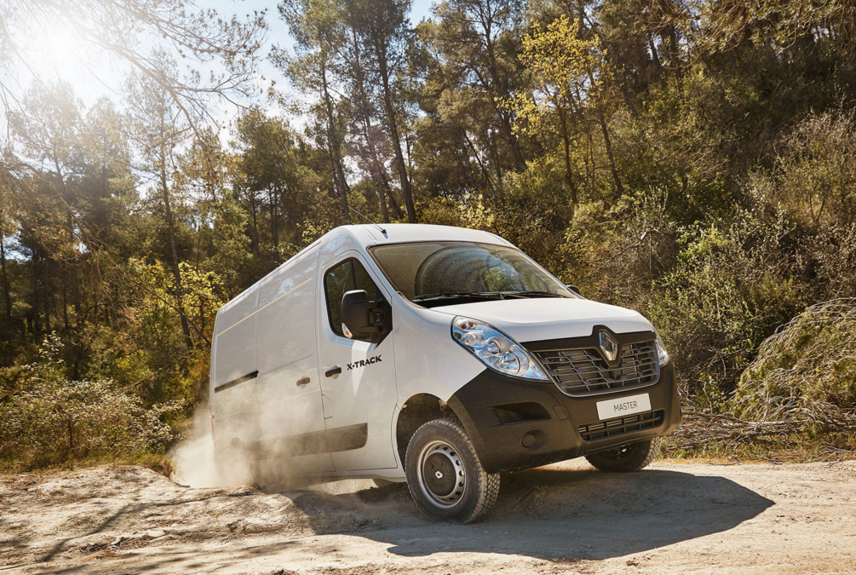Review
While many fleet operators rely on four-wheel-drive pick-ups if they need to keep mobile off-road, there are occasions when they require something with more cargo space to house equipment. However, few manufacturers market big vans with the sort of four-wheel drive capability that enables them to tackle heavily-rutted, boulder-strewn tracks or ford streams.
Pursuing a policy of covering every light commercial niche that it can think of, Renault is entering what remains a specialised sector with a 4x4 version of Master.
A conversion executed in conjunction with all-wheel drive specialist Oberaigner Automotive’s German operation, it will be on sale in the UK in early autumn. The newcomer will be sold and supported by the Renault network in the same way as the rest of the manufacturer’s light commercial line-up.
Prices have yet to be announced.
Produced in van, chassis cab and chassis double-cab versions, the Master 4x4 is available at either 3.5 or 4.5 tonnes. There is a choice of wheelbases – 3,682mm or 4,332mm – and power is delivered by a 2.3-litre dCi diesel at 125hp, 135hp or 165hp, married to a six-speed gearbox.
Ground clearance has been increased by 65mm at the front and 58mm at the back, reducing to 45mm if you opt for twin rear wheels. A lockable rear differential can be specified as an option.
Steel under-body shielding and a steel sump guard are installed and Master 4x4 is shod with all-weather tyres.
To engage or disengage four-wheel-drive you press a button on the dashboard. Four-wheel-drive can be selected when you are stationary or at speeds below 25kph/15mph just so long as the steering wheel is not turned at an angle of more than 240 degrees.
Engaging 4x4 temporarily cancels Master’s ABS and its Electronic Stability Control (ESC) system in order to give it maximum capability in what may be demanding off-road conditions. You can go back to 4x2 at below 20kph/12mph. Doing so reactivates the ABS and ESC.
The driver can hit an adjacent button to deploy a low-ratio set of gears if the going begins to get really sticky. Doing so increases available torque by approximately 40%.
The low-range gears can be engaged and disengaged when you are at a standstill with the clutch pedal depressed.
There are no plans for Oberaigner to turn out 4x4 versions of the front-wheel-drive-only Kangoo and Trafic.
Not all fleet operators need no-holds-barred four-wheel drive, however, even though they may think they do. Instead, what they often really require is a system that will get their vans along a farm road and up and down a muddy slope or two without the risk that their drivers and the cargo they are carrying will end up stuck.
In response, Renault is making something called X-Track optionally available on Kangoo, Trafic and Master. Developed in conjunction with France’s Poclain Vehicules, it is permanently-engaged. It involves swapping the transmission’s original differential in favour of a limited slip differential, boosting the ground clearance by around 30mm (Kangoo, Trafic) or 40mm (Master) and installing a 3mm-thick steel sump guard.
All-weather tyres are fitted and Kangoo is further protected by a steel under-floor shield 2mm-thick to protect its exposed fuel lines and brake pipes against damage.
If one driven wheel starts to lose traction then the limited slip differential automatically switches up to 25% of the available engine torque to the one that has the most grip. It does so by means of a mechanical torque transfer system with eight alternating friction discs.
Poclain Vehicules turns out 2,000 mobility conversions annually and already works closely with Peugeot, Citroën, Fiat and Mercedes-Benz. The agreement with Renault should result in a significant increase in output.
Like the off-roading Master, the X-Track line-up will be available on this side of the Channel in early autumn and supported by the Renault network. Again, prices have yet to be revealed.
X-Track’s launch follows on from Renault’s decision sometime ago to fit the bulk of its light commercials with Grip Xtend as standard. Derived from the ESC system, it equips the transmission with advanced traction control so that the vehicle is less likely to get stuck in snow or when trying to cross soft sand.
Grip Xtend can be chosen by pushing a button when the vehicle is stationary or at speeds below 50kph/30mph. It deactivates automatically at higher speeds.
All-weather tyres are optional.
So what are Renault’s newcomers like to drive? We went to Spain to find out and took them around a demanding four-wheel-drive course not far from Barcelona.
Master 4x4 behind the wheel
With four-wheel drive duly engaged and periodic recourse to the low-ratio set of gears, Master 4x4 chugged happily along some severely-rutted tracks and down truly precipitous slopes without breaking sweat. Generous engine braking ensured the rate of descent was kept in check.
It forged up equally steep slopes too, again without breathing hard.
We sampled the 165hp model, which generates more than enough torque to allow the Master to ease its way over obstacles without any need to depress the accelerator pedal. Furthermore, there is enough ground clearance and suspension articulation to ensure that only major obstructions will impede its steady progress.
X-Track behind the wheel
The X-Track Kangoo, Trafic and Master were all able to cope with the rough, moderately-rutted, surfaces they were asked to tackle and could overcome some remarkably-steep inclines if the driver stayed in low gear with his foot hard down on the accelerator pedal.
Although the X-Track occasionally hesitated, dogged determination kept the little van going until it wrestled its way to the top.
The conditions were bone-dry and the vehicles were unladen. So we have to reserve final judgement on their true capabilities until we have experienced them in thick mud and with some weight in the back; the sort of conditions that technicians regularly encounter in soggy Britain.
















